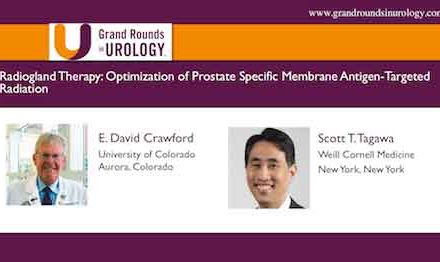Dr. Peter A. Pinto spoke at the 24th International Prostate Cancer Update on Friday, February 21, 2014 on “Molecular Targeting for Imaging and Intervention PSMA Imaging Agents.” In his presentation, Dr. Pinto discusses PSMA and its role for imaging and therapy.
Presentation
Keywords: PSMA, imaging, agents, antibody, focal therapy, small molecule, prostate
How to cite: Pinto, Peter A. “Molecular Targeting for Imaging and Intervention PSMA Imaging Agents” Grand Rounds in Urology. January 13, 2015. Accessed Jan 2025 https://dev.grandroundsinurology.com/prostate-cancer-peter-a-pinto-molecular-targeting/
Transcript
Molecular Targeting for Imaging and Intervention PSMA Imaging Agents
Thank you for a great opportunity here to speak about PSMA and its role for imaging and, maybe, therapy. I will include Peter Choyke and Baris Turkbey. They are the diagnostic radiologists in our newly-formed molecular imaging program at the NCI, where I collaborate with them, and a lot of this I’ll be speaking about is their work or their focus.
So, PSMA, you’ve heard it before. When I think of PSMA, I think of ProstaScint scanning and I think of those kinds of scans and, in essence, it is a membrane-bound protein. It is expressed in prostate. It could be seen in normal prostate, but over expressed in cancer and it is expressed in other tissues also. I’ll go into that in a few moments. But, unlike PSA, it is not secreted, membrane bound, and there were numerous reports that it correlates with PSA level, tumor stage, disease recurrence, and at times, progression, so therefore it has been sought after as a marker for labeling for either treatment or a diagnosis.
When you look at the literature in regard to how PSMA is used for imaging, it is tagged in two ways. So, think of it as one which is an antibody to PSMA. The other one is a small molecule, in this case, small urea-based molecules. Those are the two big avenues of research for imaging with PSMA, and this is the obligatory picture of the structure showing it has a large external domain transmembrane, a small internal domain. Internal domain actually has opportunities to bring in radionuclides and therefore actually has some activity of interest to basic scientists.
If you take nothing else away from this talk, just to remember, and this is a hint, that we can see this in other glands, normal prostate, brain, kidney, salivary gland, and, if you remember from the older scans, the intestinal mucosa, so that you get a blur, sometimes, in the abdomen, just from the mucosa; the brush-border membranes of the intestine. It is a function through a proteolytic enzyme but its exact role is unclear in prostate cancer. But, why target PSMA? Why has this work been done and ongoing, as we speak? Well, it is highly expressed, not secreted; it is a bound protein. Its increased expression with higher grade metastases and that is where most of the focus is, looking for otherwise occult metastases in high risk, or advanced prostate cancer.
And, as I mentioned just a little while ago, it has that kind of unique motif in its cytoplasmic domain that can help incorporate radionuclides, that makes it very helpful for imaging.
Again, two approaches for PSMA, the antibody on top and these small molecules, in this case urea-based molecules, on the bottom. When we think of antibodies, I will go into detail with ProstaScints and the J59 which is Neil Banders baby from Cornell, and then we have a few of these; this is more in preclinical, clinical models, this is more clinical. And, in essence, this was probably pushing 20 years, now, although it had a lot of hype coming out, it really did not kick off and the internal domain of the PSMAs the target and that was probably its Achilles heel.
The results were disappointing for that reason and also the uptake and diagnosis of bone lesions was poor with this agent, and so, therefore, we have heard about it. We don’t see those scans where the abdominal uptake in intestinal mucosa was too high. The noise sinplus ratio was too poor and we really could not use it, clinically and that has not changed over the years, but J591 has more promise. Again, this is coming out of New York, Neil Banders lab at Cornell. It is a humanized antibody. It is targeting the external domain and this is where the hope is.
So, here, this was challenging, clinically useful, this maybe has more promise.
You can label it either diagnostically, or therapeutically. In the therapeutic option, you can have beta-emitting radionuclides and, therefore, you have different opportunities to actually get this agent to the cells. And then there are just a few slides, going forward, showing the activity and what the clinician will see with these types of J591 imaging agents labelled, in this case, with Indium 111.
And then we have here, also, a conventional bone scan and then opportunities to label, again, the external domain of PSMA.
Now, there has been some interest in including work at our institution to bring this into the localized forum. I did not put the slides in, because it was not part of the scope of this lecture, but we had worked with C11 acetate imaging and the GE compound called FACBC, which is a leucine analog and we had used this in a program similar to what I showed yesterday where we do imaging and then correlation with surgical specimens.
This is a case, also here, from Tagawa and colleagues, where they have what we would call state of the art high resolution T2 MR imaging in multiparametric fashion combined with these PET agents, in this case J591. And what you can see is you can determine foci of interest and maybe laterality and you can look at this a Gleason 9, which is arguably a very aggressive cancer and should stand out and be bright in the background and even for Gleason 7’s the same authors reported opportunities to visualize these tumors. As you move into the lower Gleason patterns 3, it becomes a bit more challenging. And, we found similar results with C11-Acetate and FACBC and at the time, we felt that it really was not a good focal opportunity for imaging and just provided you a region of interest.
So, helpful, but not really what we needed, clinically. And there are additional monoclonal antibodies, besides J591 listed here and to date these are all in preclinical work and mostly as xenograph mouse models. This is work out of Pete Choyke’s lab at the NCI where we are trying to see if we can use this tracer as an adjunct to surgical removal of the cancer to improve either positive margin issues or things like that.
Now, this is very kind of preclinical work and I am not really sure how well it will translate to the patients, but interesting science, nonetheless. So here, they have a PC3 cell line that is PSMA positive. This is their control and what they are looking for is exciting, that tumor in this case, and then visualizing the infrared spectrum. And this is ongoing work, again with J591 with Pete Choyke and his colleagues.
Now, this has, I think probably, a little bit more promise in reviewing the literature and has some excitement. A lot of this work is coming out of Johns Hopkins, Marty Pomper’s lab, and these are small molecule opportunities, urea based.
There are multiple advantages over antibodies and they are listed here on this slide. So, first of all, small molecule, quicker clearance, the time for administration, imaging is more convenient for the patient’s schedule and opportunities to see you in clinic. Therefore, we can have now same day imaging, which makes it more applicable. The penetration is a bit better than the antibody and you can, again, label PET or SPECT imaging agents to these for attachment to the PSMA. I am going to show some of the work that was given to us by Marty Pomper, here, and has, again, really strong preclinical publications, and then some first-in-human cases, which we will have today. And another agent besides this is MIP-1072 with 1095 and, again, robust work in this field for small molecule PSMA imaging components.
And here, this is, I think, work from Marty’s lab that just shows that in what we call these mouse-imaging chambers you could have confirmation of targeting of PSMA selective with these small molecule agents. This one is his initial study in humans and really is elegant work. He has done a great job in actually trying to, for the first time, give us an opportunity to see this, what we thought was occult disease. We heard yesterday, in the abstract session after the plenary sessions yesterday, how in many patients there is occult cancer and PSA could be a hint to that. When you get to look further with CT scans or tissue and bone scans or maybe sodium fluoride scans and we will hear with the next lectures about these newer bone scans, but this really has some promise and we will hear more about it from the Johns Hopkins faculty.
Again, I can just show you a little bit about how it picks up where processing fell short, not just soft tissue metastases, but also bone metastases. And then, this was 1072 and there is one called 1095 and again, have first human uptake not just for soft tissue, but also for bone. And, when we hear, later on, in the lectures about the tissue and bone scans and sodium fluoride bone scans, where we should really put our efforts to rule out occult metastatic disease. I think we will be hearing about this in the future, also. I think we will have an option, opportunities for different agents and we will see, looking at the false positive, false negative rates going forward.
In summary, PSMA imaging, although an old friend to the imaging community has been, in a sense, reborn with the small molecule urea-based targeted agents. When you think of two approaches, it is the antibody, traditional antibody with its new flavor called J591, and then the current small molecules I just spoke about. We can use those for opportunities for looking for occult metastatic disease, possibly for intraoperative imaging to improve how we treat these diseases surgically. I think the real issue, right now, would be looking for occult disease or recurrent disease after definitive treatment with surgery or radiation, and all new information that is going to change every year. I am sure, as we come back to this program next year, we will have even more robust data to discuss, maybe newer agents that will be labelled.
Now, I want to just throw in a few slides. I have to leave after this, actually, morning session to get back to DC, but I wanted to try to be present for the focal therapy sessions. I will not be able to, so I wanted to leave with this. We have now, for the past three years, a protocol through the NCI for focal therapy with laser ablation, a little off topic and I cannot give the comments this afternoon, I will not be here, but I am going to bring back, next year, David the opportunities to get these results. These should be robust enough for publication, we hope, by next year and what we will do is we will bring them in. And, this is again with our MR program, identifying lesions that are focally treated and will have probably four- or five-year data by next year.
In addition, we have built, in the lab, a transurethral ablation device that I hope to have first-in-human experience by next year, also, by about this meeting. And, this is work in collaboration with Phillips Corporation where we built this transurethral focal ultrasound ablation device and it has been published now in BJUI, where we can go ahead and we can MR guidance pretty much ablate where we want to ablate and this was the preclinical work in canine models showing biostained destruction of not tumors, but normal prostate in the dog model, going forward. Again, we will have that information for you next year.
But I think it is a very important session today and tomorrow. I think focal therapy needs to be examined critically. I think there is a slippery slope on the opportunities for financial success by clinicians with focal therapy. I think patients want that, although there are programs in the northeast that charge an arm and a leg out-of-pocket expense to patients and I think we have to rein that in. So, I look forward to these discussions in the years ahead.
Thank you very much.
References
Nakajima T, Mitsunaga M, Bander NH, et al. Targeted, activatable, in vivo fluorescence imaging of prostate-specific membrane antigen (PSMA) positive tumors using the quenched humanized J591 antibody-indocyanine green (ICG) conjugate. Bioconjug Chem. 2011 Aug 17;22(8):1700-5. http://www.ncbi.nlm.nih.gov/pubmed/21740058
Osborne JR, Akhtar NH, Vallabhajosula S, et al. Prostate-specific membrane antigen-based imaging. Urol Oncol. 2013 Feb;31(2):144-54. http://www.ncbi.nlm.nih.gov/pubmed/22658884
Partanen A, Yerram NK, Trivedi H, et al. Magnetic resonance imaging (MRI)-guided transurethral ultrasound therapy of the prostate: a preclinical study with radiological and pathological correlation using customised MRI-based moulds. BJU Int. 2013 Aug;112(4):508-16. http://www.ncbi.nlm.nih.gov/pubmed/23746198
Tagawa ST, Milowsky MI, Morris M, et al. Phase II study of Lutetium-177-labeled anti-prostate-specific membrane antigen monoclonal antibody J591 for metastatic castration-resistant prostate cancer. Clin Cancer Res. 2013 Sep 15;19(18):5182-91. http://www.ncbi.nlm.nih.gov/pubmed/23714732
Vallabhajosula S, Goldsmith SJ, Hamacher KA, et al. Prediction of myelotoxicity based on bone marrow radiation-absorbed dose: radioimmunotherapy studies using 90Y- and 177Lu-labeled J591 antibodies specific for prostate-specific membrane antigen. J Nucl Med. 2005 May;46(5):850-8. http://www.ncbi.nlm.nih.gov/pubmed/15872360
ABOUT THE AUTHOR
Peter A. Pinto, MD, is an Investigator and faculty member in the Urologic Oncology Branch of the National Cancer Institute in Bethesda, Maryland. Following a residency in Urologic Surgery at Long Island Jewish Medical Center - Albert Einstein College of Medicine in New York, he was a Fellow and Clinical Instructor at the Brady Urologic Institute at Johns Hopkins Hospital in Baltimore, Maryland. Dr. Pinto is a board-certified urologic surgeon specializing in oncology and is the Director of the Urologic Oncology Fellowship Program at the National Cancer Institute. He is nationally and internationally recognized as an expert in the minimally invasive treatment of urologic cancers, specializing in laparoscopic and robotic surgery for prostate, kidney, bladder, and testicular cancer.





